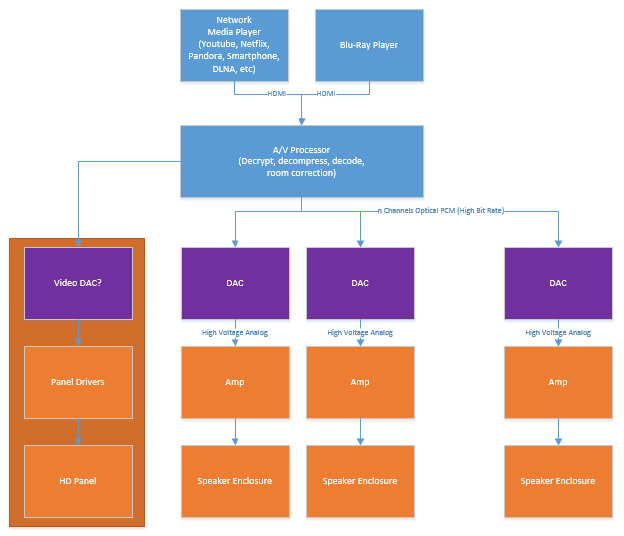In a hifi setup, what is the best place to locate the DAC?
The key requirements are:
- Upgradeability
- Compatibility
- Absolute quality
When the components are broken down into their respective functions the upgradability improves. Initially the cost goes up due to chassis costs, additional test time, etc. But down the road each function can be upgraded while the rest stays in place.
Compatibility is obtained by choosing gear that uses standard outputs and adheres to well known standards.
Quality is obtained by a) maintaining transparency in the signal path, b) high quality power source and room, c) keeping the entire path digital until the very end and d) optical isolation.
In a separates system each component has inputs and outputs that are specced. They only perform one function and it is easier to understand and trust what's going on inside the box.
High quality power source is both steady, clean and capable of large amounts of transient power. A high quality listening room is designed to be quiet and free of reflections or nasty peaks and nulls.
Because our source is digital it makes sense to keep that signal digital and undisturbed until it's conversion to analog at the load. This would imply that decryption, decompression and decoding do not color the signal (insofar as that is possible). Of course room correction will intentionally color the signal but what I'm referring to here are errors caused by bad or careless design. This also decouples the lifestyle functionality that is present in AVRs and decouples it from the DAC. DACs are the most critical, most expensive (in hardware terms) part of an AVR. It is a shame that we have to sacrifice functionality for higher quality conversion and vice-versa. You could in theory buy a digital only decoder from a mass market, high volume brand that has the expertise to delivery a high quality user experience and couple that with very high end DACs. I'm not saying this is cheaper, but even if (in a pre/pro system) the DAC were moved to the amp and the interconnects were optical there would be an advantage.
Finally, optical isolation between the digital and analog portions by using optical cables between the processor and the DACs would eliminate must of the noise and coupling that could occur.
It isn't clear that there is an advantage to separating out the components in a television. The panel and panel drivers are intimately coupled and couldn't be separated anyways (number of connections is extremely high). It could be possible to separate out the video processing in the DAC and also move the "Home screen"/command console software from the TV to the DAC. The latter could be interesting, particularly if it were all moved to one of the sources, but again moving the video processor out doesn't make sense. It would be viewers more control over the picture that's displayed but I'm not sure how practical that is.
